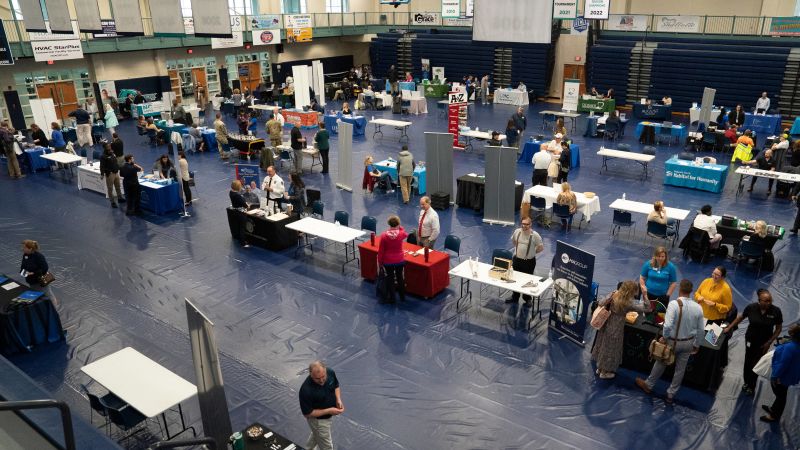CNN
—
US job growth slowed considerably last month, with just 175,000 positions added in April, according to Bureau of Labor Statistics data released Friday.
The slower-than-expected gains — April’s tally is the lowest since October of last year — come as the Federal Reserve has sought to cool demand to tame high inflation.
Economists have anticipated the labor market would see a gradual slowdown due to the pressure of high interest rates.
Markets surged on the news, with Dow futures up by 505 points, or 1.3%; S&P 500 futures were up 1.1% and Nasdaq futures gained 1.5%.
Although April’s jobs numbers are sharply cooler than the upwardly revised 315,000 gains notched in March, they’re in line with what was seen pre-pandemic and the neutral rate of job growth to keep pace with population gains. In the decade before the pandemic (which also was the nation’s longest-ever period of employment expansion), monthly job gains averaged 183,000.
“From a bigger picture standpoint, you see a labor market that’s still pretty strong, pretty tight,” Michael Pugliese, senior economist with Wells Fargo, told CNN in an interview Friday. “This is a far, far cry from 2020 or 2009 or the outright weak labor markets we’ve seen over the past 15 or so years.”
“But it is clear at this point that this is not as tight of labor market as what we had at the peak there in late-’21, much of 2022.”
The unemployment rate ticked higher to 3.9%, according to the Bureau of Labor Statistics. April marks the 27th consecutive month that the jobless rate has held under 4%, matching a streak last seen in the late 1960s.
Economists were expecting 235,000 jobs were added last month and for the jobless rate to hold steady at 3.8%, according to FactSet consensus estimates.
Nearly half (about 87,000) of April’s employment gains were in the health care and social assistance sector, which has been a key driver of job gains. The remaining job growth was fairly broad-based across other industries, with some of the bigger gains recorded in transportation and warehousing and retail trade.
At the start of 2024, it looked as if an economic acceleration was at play. The inflation data kept coming in hot, spending remained strong, pay growth didn’t ease as expected, and job gains outpaced what was seen in 2023.
But there were indications that a cooldown was ahead. For the labor market, specifically, wage growth was moderating and turnover data showed that fewer jobs were available, hiring activity was tailing off and people weren’t quitting as much.
“I don’t think this [175,000 net gain] is a doom and gloom number; I think it’s a right-sizing number,” Jane Oates, a former Labor Department official who serves as senior policy adviser for employment education nonprofit WorkingNation, told CNN.
The question over the coming months will be whether this is setting up a new normal for the labor market, she added.
Following Friday’s report, which also included revisions that showed 22,000 fewer estimated job gains in February and March combined, the pace of job growth is now slightly below what was seen last year, BLS data shows.
Through April, US employers have added an average of 245,500 jobs per month, versus 2023’s 251,000-per-month average.
The labor force participation rate held steady at 62.7%; however, Friday’s report showed that prime working age participation, particularly among women, grew.
The labor force participation rate for women aged 25 to 54 years of age rose by 0.3 percentage points to hit an all-time high of 78%.
Also, the unemployment rate for Black workers fell back down to 5.6% (a rate seen in February) after suddenly spiking to 6.4% in March. Economists at the time cautioned that the increase was “likely more signal than noise,” given volatility in the household survey component of the jobs report; however, it was an important data point to watch.
What this means for the Fed — and rates
Wage growth also slowed notably: Average hourly earnings increased 0.2% from March and 3.9% during the past year. Annual wage gains, as measured by the BLS, are at their lowest level since May 2021.
Fed officials are closely monitoring the trajectory of wage gains, as there’s a concern that accelerated compensation growth may serve as an inflation pressure.
Fed Chair Jerome Powell said earlier this week that the central bank will not start loosening its tight monetary policy until there’s a clear slowing in inflation (which has come in hot this first quarter) or a sudden and unexpected weakening in the labor market.
While the job gains were lower in April, Friday’s report doesn’t trigger the latter, economists and analysts said.
“For those looking for a rate cut sooner than later, this deceleration in payroll growth is good news, and the weaker wage growth number makes it even better news,” Olu Sonola, Fitch Rating’s head of US economic research, said in a statement.
“However, one month does not make a trend, so the Fed will likely need to see a few months of this type of moderation coupled with better inflation numbers to put rate cuts back in play sooner than later.”
Wells Fargo’s Pugliese said that while employment data is important to the Fed, “the inflation data is really what’s driving the bus here.”
“As long as job growth stays north of 100,000 and below 350,000, a nice big range where you’re not imminently falling off a cliff or running at a super, super hot pace, I think the real big swing factor is going to be what’s happening in the [inflation] reports,” he said.
The next report for the Consumer Price Index, the most widely used gauge of inflation, will be released on May 15.
Correction: This story has been updated to correct the date of the next CPI release. It is May 15.














